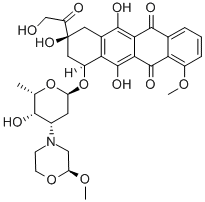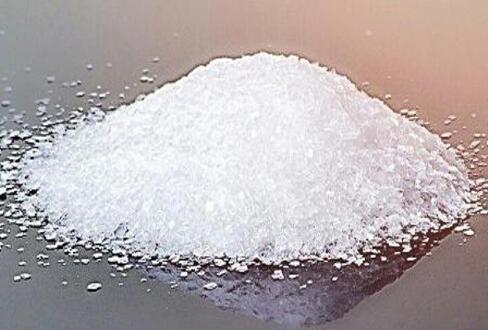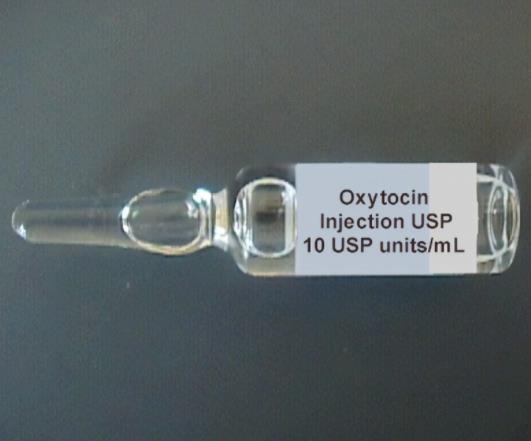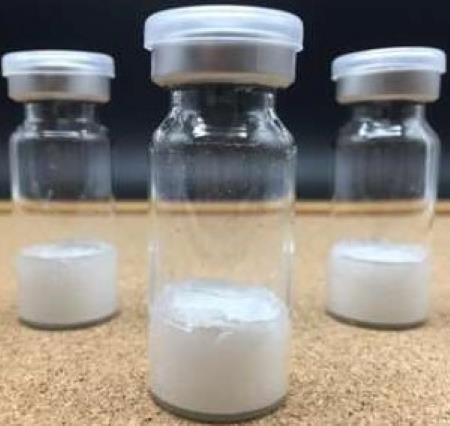Nemorubicin:Metabolism and Pharmacokinetics, Cytotoxic Activity And Toxicity Studies
General Description
Nemorubicin is a member of the structural group of morpholinyl anthracyclines whose lead compounds were originally obtained by Takahashi et al. [1] and also by Acton et al.[2] and characterized, especially the cyanomorpholino derivative, as new intensely potent semisynthetic anthracyclines. The drug was reported to be active in vitro against both murine and human tumor cells resistant to doxorubicin. Similar results were obtained when the drug was administered in vivo to mice bearing multi-drug resistant tumors. The compound retained the same activity also in alkylating agents and topoisomerase II resistant tumors and showed an increased potencyrelative to the parent drug doxorubicin. It is metabolized via P450 CYP3A enzyme to an extremely cytotoxicderivative. Both nemorubicin and its metabolite have a mechanism of action different from that of doxorubicin, with a key role played by the nucleotide excision repair system. The drug is actively tested in clinics as a single agent or in combination with cisplatin.[3]

Figure 1 nemorubicin powder
Metabolism and Pharmacokinetics
Preincubation of nemorubicin with human liver microsomes in the presence of nicotinamide adenine dinucleotide phosphate (NADPH) increased by 50-fold the in vitro cytotoxicity of the drug against human ovarian carcinoma-derived cells ES-2.[4]This increase in potency was abolished by co-incubation with cyclosporin A, a substrate of cytochrome P450 3A. Moreover, a difference in the kind of DNA damage was found, with nemorubicin being able to induce single and double strand breaks in the absence ofmicrosomes and shifting to the formation of DNA crosslinks when incubated in the presence of activated microsomes. [3] Experiments performed using cDNA-expressed CYP3A enzymes identified the human CYP3A4, the major isoform of CYP3A enzyme in human liver, as the most active enzyme responsible for the activation of nemorubicin. CYP3A1 and CYP3A2 rat enzymes were also able to induce the activation of the drug. Conversely, human CYP3A5 and CYP3A7 were not able to significantly transform nemorubicin.[5]
PNU-159682 was also identified as a P450-dependent metabolite of nemorubicin.[6] Kinetic analysis about the formation of this metabolite showed that the reaction was linear over a range of concentration of the substrate indicating that a single microsomal enzyme or different enzymes with a similar apparent Km are able to catalyze the conversion ofnemorubicin to PNU-159682.[3]Microsomal preparations containing single recombinant human cytochrome P enzymes were in fact used to follow the conversion of nemorubicin to PNU-159682.[6]CYP3A4 expressing preparations effectively transformed nemorubicin, while microsomes containing CYP1A2, CYP2A6, CYP2B6, CYP2C8, CYP2C9*1, CYP2C19, CYP2D6∗1, CYP2E1, CYP3A5, were not able to produce detectable amounts of PNU-159682.[3]
Cytotoxic Activity
Nemorubicin is active in vitro as well as in vivo against murine and human tumor cell lines resistant to doxorubicin, to other P-glycoprotein and multidrug resistance protein (MRP) substrates and to topoisomerase II inhibitors.It is also more potent than the parent drug and retains activity in tumors resistant to alkylating agents and topoisomerase I inhibitors. [16-19]
In Vitro: Nemorubicin was active in vitro against several murine and human cancer cell lines, always showing higher potency than doxorubicin.And nemorubicin uptake was faster but was also always present in higher amounts based on research comparison.[3]In vitro activity of nemorubicin against human leukemia and lymphoma cell lines, Kuhl et al. found that in all the 14 human cell lines examined, nemorubicin was more active (5 to 7 times) than doxorubicin.[7]In a panel of human hepatocellular carcinoma-derived cell lines, nemorubicin was more than ten times more potent than both doxorubicin and epidoxorubicin.[8]In the aspect of activity against resistant cells, being structurally related to doxorubicin, nemorubicin was initially tested for its activity against resistant cells presenting the multi-drug resistance (mdr) phenotype. Interestingly, nemorubicin retained its activity against a panel of cancer cell lines having a high degree of resistance to doxorubicin due to the expression of mdr or multi-drug resistance related protein (MRP) [7, 9–11,13-14].Nemorubicin showed also activity against cell lines selected for resistance to agents acting with a mechanism of action different from that of doxorubicin, including platinum derivatives, alkylating agents and topoisomerase I and II inhibitors [7, 9, 12].
In vivo:Nemorubicin produced antitumor activity similar to that of doxorubicin at doses approximately 100 times lower in vivo experimental systems test.This is likely to be due to the formation of a more potent metabolite via the P450 CYP3A isoenzyme.[3The related vitro research showed that nemorubicin retained the antitumor activity in vivo against cells resistant to different drugs including anthracyclines, platinum derivatives, and alkylating agents. Nemorubicin showed appreciable activity even when administered orally.[15]This model in fact preferentially metastatizes to the liver. Differently from doxorubicin, nemorubicin, injected intravenously, was more active in reducing liver metastasis than in reducing primary tumor. This relative preference for liver metastasis was confirmed by oral administration of the drug.[3]
Toxicity
Nemorubicin can overcome multi-drug resistance associated with decreased intracellular uptake.Cells selected for resistance to nemorubicin show collateral sensitivity to alkylating agents and platinum derivatives.Based on some clinical studies,nemorubicin,reversible myelotoxicity with a delayed nadir in comparison with doxorubicin, showed the dose limiting toxicity. At these dose levels,side effects were nausea and vomiting and transient increase in hepatic transaminases. About the intravenous route, the main hematological toxicity was neutropenia which was found to be highly variable among patients.Based on previous research results, moderate toxicity was observed in these treatment conditions with moderate reversible increase in transaminases.In terms of cardiotoxicity, nemorubicin did not show any significant alteration indicating a markedly less cardiotoxicity in vivo compared to doxorubicin.When combined with DDP it shows synergistic antitumor activity without increase in toxicity.[3]
Reference
[1]Takahashi Y, Kinoshita M, Masuda T, et al.(1982) J Antibiot 35:117.
[2]Acton EM, Tong GL, Mosher CW, et al.(1984) J Med Chem 27:638.
[3]Broggini, M. (2007). Nemorubicin. In: Krohn, K. (eds) Anthracycline Chemistry and Biology II. Topics in Current Chemistry, vol 283. Springer, Berlin, Heidelberg. https://doi.org/10.1007/128_2007_6.
[4]Lau DH, Duran GE, Lewis AD, et al.(1994) Br J Cancer 70:79.
[5]Lu H, Waxman DJ (2005) Mol Pharmacol 67:212 12.
[6]Quintieri L, Geroni C, Fantin M, et al.(2005) Clin Cancer Res 11:1608–1617.
[7]Kuhl JS, Duran GE, Chao NJ, et al.(1993) Cancer Chemother Pharmacol 33:10.
[8]Yuan S, Zhang X, Lu L, Xu C, et al.(2004) Anticancer Drugs 15:641.
[9]van der Graaf WT, Mulder NH, Meijer C, et al.(1995) Cancer Chemother Pharmacol 35:345.
[10]Bakker M,Renes J,Groenhuijzen A,et al.(1997) Int J Cancer 73:362.
[11]Michieli M, Damiani D, Michelutti A, et al.(1996) Haematologica 81:295.
[12]Alvino E, Gilberti S, Cantagallo D, et al.(1997) Cancer Chemother Pharmacol 40:180.
[13].Grandi M, Pezzoni G, Ballinari D, et al.(1990) Cancer Treat Rev 17:133.
[14]Grandi M, Ballinari D, Capolongo L, et al.(1991) Haematologica 76(Suppl 3):181.
[15]Geroni C, Quintieri L,Valota O,et al.(2002) Eur J Cancer 38:S19.
[16]Bakker M, Renes J, Groenhuijzen A, et al. Mechanisms for high methoxymorpholino doxorubicin cytotoxicity in doxorubicin-resistant tumor cell lines. Int J Cancer 1997, 73(3):362-366.
[17]Mariani M, Capolongo L, Suarato A, et al. Growth-inhibitory properties of novel anthracyclines in human leukemic cell lines expressing either Pgp-MDR or at-MDR. Invest New Drugs 1994, 12(2):93-97.
[18]Ripamonti M, Capolongo L, Melegaro G, et al. Morpholinylanthracyclines: cytotoxicity and antitumor activity of differently modified derivatives. Invest New Drugs 1996, 14(2):139-146.
[19]Quintieri L, Rosato A, Napoli E, et al. In vivo antitumor activity and host toxicity of methoxymorpholinyl doxorubicin: role of cytochrome P450 3A. Cancer Res 2000, 60(12):3232-3238.
You may like
Related articles And Qustion

US $15.00-10.00/KG2021-07-13
- CAS:
- 108852-90-0
- Min. Order:
- 1KG
- Purity:
- 99%+ HPLC
- Supply Ability:
- Monthly supply of 1 ton

US $15.00-10.00/KG2021-07-09
- CAS:
- 108852-90-0
- Min. Order:
- 1KG
- Purity:
- 99%+ HPLC
- Supply Ability:
- Monthly supply of 1 ton



